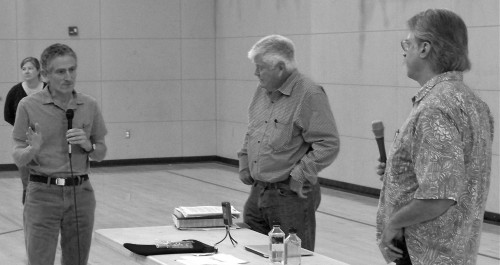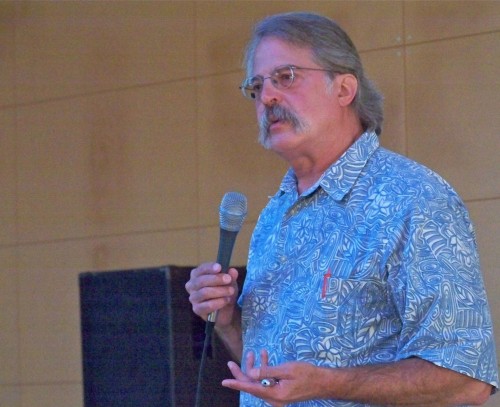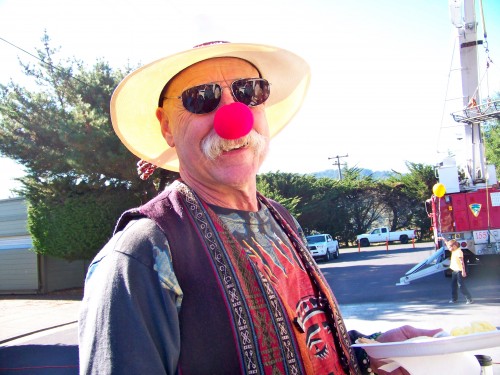The Marin County Deputy Sheriffs Association held its annual barbecue Sunday at Stafford Lake. There were no reports of rowdy deputies crashing cars or getting in fights with each other. It wasn’t always like that.
A just-released book, Resident Deputy Sheriff In Wild and Wooly West Marin: 1964 to 1969 and then some!, describes heroism, humor, and scandals within the Marin County Sheriff’s Office four decades ago.
Numerous well-known residents of West Marin play roles in the book: retired Judge Dave Baty of Inverness Park, retired Sheriff’s Sgt. Russ Hunt of Point Reyes Station, the late Sheriff’s Capt. Art Disterheft of Olema (for whom the Public Safety Building in Point Reyes Station is named), and others.

Sheriff’s Capt. Art Disterheft (left) and Sgt. Weldon Travis in Inverness Park during the Storm and Floods of 1982. Portrait copyright Art Rogers/Point Reyes
Written by a retired sheriff’s sergeant, the book provides — among other things — an insider’s look at the sheriff’s office during the 1958-to-1978 tenure of Sheriff Louis Mountanos who, according to the author, had ties to La Cosa Nostra.
Weldon Travis, the author, knows West Marin well. He moved to Woodacre after high school, attended the College of Marin, and in the 1960s became a deputy in the county sheriff’s office.
While still a young officer, Travis was made a resident deputy in West Marin, meaning he was patrolling the area where he lived.
Along with accounts of heroism, tragedy, and official wrongdoing, his book includes numerous anecdotes that are humorous in the understated vein of Sheriff’s Calls. But unlike them, he often names names:
“I had a civil paper to serve on George [Gallagher of Nicasio], nothing serious, and went to his house.” His wife told me he and a bunch of his friends were deer hunting a few miles away in the canyons along Wilson Hill.
“George was getting along in years, so he was sitting down near the base of a canyon as some of the younger guys were hopefully driving the deer toward the older ones.
“I spotted George’s International jeep and figured I’d find him, hopefully without messing up the hunt. I stayed in the open and moved slowlyas I didn’t want to get shot by accident.
“Pretty soon I heard a big one come crashing down through the oaks and madrones, then the nearby crack of a rifle. I moved that way and found George sprawled on the hillside between some big rocks. The big ol’ buck had knocked him ass over teakettle downhill.
“George looked up at me with kind of a dazed expression on his face, and in that high voice of his asked, ‘Weldon, how did you get here so quick?” I just grinned at him.

Retired Sheriff’s Sgt. Weldon Travis at the Pinecone Diner Saturday.
Another of his stories tells of a naked man high on drugs trying to have sex with a patrol car’s red light as a new deputy from Nicasio, Joe Dentoni, drove around Point Reyes Station.
Still another story tells of stopping a motorist in the San Geronimo Valley late one summer evening. Seeing the man’s car wandering around its lane at varying speeds, Travis assumed he was dealing with someone who was either really sleepy or intoxicated.
However, when Travis turned on his siren, up popped a blonde, long-haired woman, sitting bolt upright in the front passenger seat. After talking with the two and running a warrant check, Travis writes, I sped off, leaving them to recompose themselves at roadside.
Some of Travis’ stories are grim. A cat lady, who had been dead for several days, was found at home in Woodacre. The cats didn’t have any food except her. Travis helped the coroner put her in a body bag although her forearm skin slipped off as I pulled her off the bed.
More emotionally wrenching for Travis was arriving at a Lucas Valley Road home just as a resident committed suicide with a gunshot into his mouth and brain.
After the coroner had come and gone, Travis gathered up the blood-soaked quilts, blankets, sheets and pillows and threw them in the trunk of the patrol car.
The new widow and I got some Clorox from under the sink and got down on our hands and knees together and scrubbed and scrubbed.
At home, I washed all of that stuff three times, but it was useless. It all went to the dump. My emotions and some of my sanity took a dump too.

Travis describes the suicide of a fellow officer, as well as his own alcoholism, marital infidelities and indiscretions.
“Why do I share this?” he asks at one point. “So you might understand what we who serve you do. We pay a price, but that’s okay; it’s our choice. And that’s why we drink, have failed relationships, and commit suicide after our usefulness to our society seemingly has been utilized.
Travis also marvels at the heroic strength of some of the public with whom deputies deal.
In a section titled Abbott’s Lagoon Drifter, the author tells of two, young lady-friends who calmly reported that an armed, would-be rapist had accosted them at Abbott’s Lagoon in the Point Reyes National Seashore.
One of the young women had learned martial arts while attending UCLA, and together they took the drifter’s gun away and violently beat him. With help from the public and a marijuana-hunting helicopter, deputies a day later found the man and arrested him.
“He pled guilty and, in view of his extensive rap sheet from across the Midwest, went to prison for a long time,” Travis wrote, adding, “Good community effort!”
Ironically, Travis himself doesn’t tell the story for which he is best known although his book includes an epilogue of news clippings that tell it for him.
In the 1950s while Travis was a starving student at the College of Marin, he was hired to pose naked for a photographer who said the pictures would be used in art classes.
Around 1966, after Travis was working for the sheriff’s office, pirated copies of the photos began circulating in the soft-core porn world. Soon they were showing up in gay men’s magazines such as Tomorrow’s Man, Fair Fellows, and Times Square Stud.
Someone (Travis believes it was an organized-crime figure whose toes he had stepped on) brought the photos to the attention of Sheriff Mountanos, who fired him.
The indiscreet photos would cause the public to lose confidence in him, the sheriff claimed. The claim, however, was met with a chorus of outrage from members of the public who noted what a good deputy Travis was.
Several people wrote letters to the Marin Independent Journal, saying that nothing about posing nude for an art class disqualified Travis to later work as a deputy.
With Judge Baty defending him, Travis took his firing to the county personnel commission, who reinstated him on a 4-to-1 vote.
The late San Francisco Chronicle columnist Herb Caen at the time wrote that Mountanos had “made himself look fairly ridiculous” and noted that future President Herbert Hoover had helped pay his way through Stanford University by “posing in the raw for art students.”

Weldon Travis and his wife whom he refers to as “Serene Irene, the Bawdy House Queen.”
Travis, now 74, lives in the town of Rough and Ready, Nevada County, where he is married to an 80-year-old artist, former beauty queen, and model named Irene.
Once known as a somewhat-hippie deputy, Travis is now a full-fledged-hippie political conservative — sporting long hair, a ring in his ear, and Indian jewelry. How did that change come about?
Irene said they consider themselves “compassionate conservatives,” socially liberal and economically conservative. Above all, the former sheriff’s sergeant is overtly skeptical about the workings of government. Perhaps from seeing them at close range.
Resident Deputy Sheriff is available at Point Reyes Books for $22 hardback and $12 softcover. Non-West Marin residents can find it in some East Marin bookstores and online.




























































